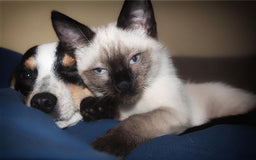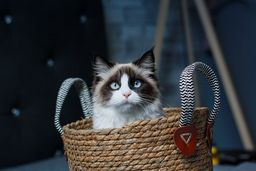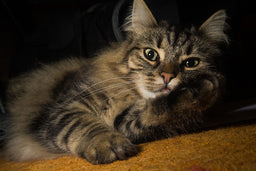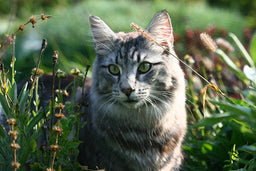Norwegian Forest cat colours and patterns—all in one place
If you have ever had the pleasure of meeting a Norwegian Forest cat, you know how gorgeous they are and how wonderful their temperament is. They are large kitties who enjoy the company of humans and other animals and get on with everyone. What you might not know is that these felines come in almost all conceivable colours and patterns. According to the Cat Fanciers Association, there are more than sixty different variations.
Untamed guides you through various Norwegian Forest cat colours and patterns and explains some basic principles regarding their coat care.
Norwegian Forest cat patterns
Norwegian Forests, nicknamed Wegies, come in numerous shades and colour combinations. To classify them more easily, breed specialists determined seven different pattern categories:
- Solid
- Chinchilla
- Shaded
- Tortoiseshell
- Smoke
- Tabby
- Calico
Solid Norwegian Forest cats

White Norwegian Forest cats are the rarest and have fragile health.
Source: David Yu
Solid means that a feline is entirely in one shade. There are no other tones, markings, or patches of colour.
The table below presents all the recognised colours of Norwegian Forests:
|
Colour |
Description |
|
White |
White Wegies are rare, and their fur glistens because it doesn’t have pigment. These kitties have pink noses and paw pads, and they often have blue eyes |
|
Black |
Black Norwegian Forests have a coal-black coat, with no shading from the root to the tip of the hair. These kitties should also have black noses and paw pads |
|
Blue grey |
Blue grey is a diluted version of black. These kitties carry a gene that causes the faded colouration of the fur. They should preferably have blue paw pads and noses |
|
Red |
Red is also called orange or ginger and comes in a range of shades, from red to pale peach. Brick-red noses and paw pads are prefered in red Wegies |
|
Cream |
Cream is a diluted version of red and lighter shades are preferred. There should be no colour variations from the root to the tips of the hair. Cream Wegies should ideally have pink paws and noses |
Chinchilla Wegies
Norwegian Forests with a chinchilla pattern have an undercoat in one colour and tips on the back, sides, head, and tail in a different, darker shade. This often gives their fur a shimmering effect, especially as they move.
Below are the possible chinchilla variations:
|
Chinchilla shade |
Description |
|
Silver |
A chinchilla silver Wegie has a white undercoat with black tips on the back, head, tail, and sides. The legs can be in a lighter shade, but the belly, chest, chin, and ear tufts should be white. A brick red nose and black paw pads are preferred |
|
Golden |
These kitties have a rich cream undercoat and black tipping on the head, tail, back, and sides. The belly, chest, chin, and ear furnishing should also be cream. A dark pink nose and black paw pads are desirable |
|
Red |
Also known as shell cameo, red chinchilla Wegies have a white undercoat with red tips on the head, back, tail, and sides. The face and legs can also be lightly tipped. Chest, stomach, chin, and ear tufts should remain white, and pink paw pads and noses are preferable |
Shaded Norwegian Forests

Shaded and chinchilla patterns are similar. The only difference is the contrast between the shades.
Source: chasingtailsnz
The shaded colour pattern is similar to the chinchilla, but the contrast between the light undercoat and darker tipping on the flanks, head, tail, and along the back is more prominent.
Here are the recognised options and their descriptions:
|
Shaded colours |
Description |
|
Silver |
Shaded silver Wegies have a white undercoat with a lot of black tipping on the flanks, head, back, and tail. The area across the spine should be the darkest, and the shade should gradually become paler towards the flanks. The stomach, chest, chin, and area under the tail should be white. Black paw pads and a brick-red nose are preferred |
|
Golden |
These kitties have a warm-toned cream undercoat with substantial black tipping. As with the shaded silver pattern, the spine area should be the darkest, and the colour should become paler as it moves toward the sides. The chest, belly, and chin should be solid cream, the paws should be black, and the nose deep pink |
|
Red |
Also called shaded cameo, this pattern entails a white undercoat with a lot of red tipping on the back, sides, face, and tail. The fur along the back is the darkest and fades gradually to white on the chin, chest, and belly. Red-shaded Wegies should also have pink paw pads and noses |
The tortoiseshell pattern
Tortoiseshell felines have a coat resembling the particoloured shell of a tortoise. An interesting fact about these kitties is that they are almost exclusively females. In rare instances when a tortie is a male, he is most often sterile.
This pattern comes in several variations, as presented in the table below:
|
Tortoiseshell variations |
Description |
|
Shell |
Shell tortoiseshell Wegies have a white undercoat with red, cream, and black tips on the sides, head, back, and tail. The chest, stomach, chin, and ear tufts should be white. These kitties should preferably have a cream or red blaze on the face |
|
Shaded |
These kitties also have a white undercoat with a lot of black tipping and clearly defined patches of red and cream. A cream or red blaze on the face is preferable |
|
Smoke |
A smoke tortoiseshell Norwegian Forest has a white undercoat with a lot of black tipping and patches of cream and red. The area around the neck and ear tufts should be white, and a red or cream blaze on the face is preferable |
Smoke Wegies

I’m magical. Until I move, you can’t tell what colour I am.
Source: dendoktoor
The smoke pattern makes a feline seem one colour when resting, but when they move, the light undercoat appears. Besides the smoke tortoiseshell mentioned above, there are a few more variants:
|
Smoke shades |
Description |
|
Black |
Black smoke Wegies appear black when they are not moving, but when they walk or run, their white undercoat becomes visible. The area around the neck and ear furnishings should be pale silver. Black paws and noses are desirable |
|
Blue |
These kitties are blue, and the white undercoat can be seen when they move. Their body, legs, and face are blue, but the frill and ear tufts are white. The nose and paw pads should also be blue |
|
Cream |
Cream smoke Norwegian Forests have a white undercoat with cream tipping, invisible until the kitty moves. These felines have a white frill and ear furnishings, and they should have pink noses and paw pads |
|
Cameo |
Cameo smoke or red smoke Wegies have a white undercoat, red tipping, white frill, white ear tufts, pink paw pads, and pink noses |
|
Blue-cream |
Wegies in this pattern have a white undercoat, blue tipping, and cream patches. Their mask and points should be blue-cream, and ear tufts and necks should be white. A cream blaze on the face is preferable |
Tabby Norwegian Forest cats
The most popular and recognisable cat pattern is tabby or agouti.
A classic tabby Norwegian Forest cat has dense, defined markings on the body, as well as an "M" shape on the forehead, swirls on the cheeks, and a black line down the back. Their tails also have rings and butterfly markings on the shoulders. The patterns on the flanks should be symmetrical. These felines should have two rows of button markings on the chest and belly, which can also be white.
There are four tabby patterns:
|
Tabby patterns |
Description |
|
Mackerel |
|
|
Patched |
|
|
Spotted |
|
|
Ticked |
|

There are four tabby patterns, and they can be in all imaginable shades and combinations.
Source: DrNickStafford
Tabby patterns can come in many different shades. The table below presents the most common ones:
|
Tabby colours |
Descriptions |
|
Silver |
|
|
Blue |
|
|
Red |
|
|
Brown |
|
|
Cream |
|
|
Cameo |
|
Calico Wegies

I’m confused. Am I calico, chinchilla, or shaded?
Source: lenalindell20
The classic calico Norwegian Forest has a white coat with black and red patches. The areas that should be white include:
- Stomach
- Chest
- Muzzle
- Legs
- Feet
Besides the classic variant, Calico Wegies can be all sorts of colour combinations, including:
- Blue-cream
- Bi-colour
- Van calico
- Tabby and white
- Amber
- Blue, cream, and white
Other Norwegian Forest cat colours
A Norwegian Forest cat can be practically any colour or pattern. The unrecognised shades and patterns include:
- Chocolate
- Lilac
- The Himalayan pattern
- Combinations of these and white
Caring for a Norwegian Forest cat's fur

Don’t forget to brush me today. I feel like I need some more pampering.
Source: yamabon
To ensure your Wegie's coat is healthy and good-looking, you must care for them properly. Regardless of their shade and pattern, caring for your feline companion should consist of:
Grooming a Norwegian Forest cat
Although Wegies have dense, semi-long fur, caring for it is relatively straightforward.
Here's what grooming a Norwegian Forest cat should entail:
- Brushing—Once a week, or more often during the moulting season
- Bathing—Not more often than every two months, unless your kitty gets dirty
- Teeth cleaning—Preferably every day
- Eye and ear cleaning—Every time you bathe your kitty
- Nail trimming—When necessary
Regular grooming and high-quality food can also help reduce shedding. Since Norwegian Forests produce relatively small amounts of Fel d 1, the protein responsible for most cat allergies in humans, with proper care, these kitties may even be good companions for cat-allergy sufferers.
Feeding your Norwegian Forest cat

Nutrition significantly impacts your kitty’s coat health and appearance.
Image (c) Untamed
Well-balanced and well-portioned high-protein cat food ensures your Wegie gets all the nutrients they need to have a healthy and pretty coat. Food rich in animal protein can help prevent allergies, reduce shedding, hydrate the skin, and improve your kitty's overall health.
The best feline diet mimics their natural feeding habits. In the wild, cats hunt:
For domesticated kitties, wet food full of meat and fish will do the trick. Vegan or vegetarian meal plans won't keep your Wegie happy or healthy. As obligate carnivores, felines lack the necessary enzymes to digest carbs and plant protein. They can't get the required nutrients, so they can consequently suffer from gastrointestinal problems—such as:
The primary ingredient in your kitty's food should be lean meat or fish, including:
You can also give them small quantities of beef, lamb, ham, bacon, and pork. Be careful with these because they contain a lot of fat. If you overdo it, your Norwegian Forest can gain unnecessary weight.
It would be best to avoid proteins derived from grains (rice, wheat, soya, corn, sweetcorn) and vegetables (peas, carrots, broccoli, potatoes, beans). Although these ingredients are not toxic to felines, they can cause allergic reactions and indigestion.
Whatever type of cat food you choose—wet, dry, semi-moist, raw, B.A.R.F., or homemade—make sure it has the recommended nutrient ratio:
- More than 50% animal protein
- Less than 20% animal fat
- Under 3% carbs
How can Untamed help keep your Norwegian Forest's coat healthy and pretty?

You won’t ever have to worry about your Wegie’s coat with Untamed.
Image (c) Untamed
With Untamed, keeping your Wegie's coat in perfect condition is a walk in the park.
We offer:
- High-protein food—Our products contain at least 60% meat and fish with a dash of animal fat
- Allergen-free formulas—We don't use common allergens, so sensitive felines can enjoy our delicacies
- Vet-formulated recipes—Our recipes are created by veterinarians to provide balanced nutrition for kittens, adults, pregnant queens, neutered males, senior cats, and kitties struggling with dental issues, diabetes, obesity, hyperthyroidism, etc.
- Human-grade ingredients—We only use top-quality whole meat and fish and skip questionable meat derivatives and other filler ingredients
- Gently steamed meals—Our cooking method ensures our dishes keep all the nutrients and fantastic taste locked in. Even if your Wegie doesn't like wet food, they won't resist Untamed jellies and gravies
- Ethically produced cat food—We only cooperate with sustainable and cruelty-free suppliers, our packaging is 100% recyclable, and we operate on a carbon-neutral basis
Take our online quiz, and we'll help you create a tailor-made meal plan for your feline friend.
Ordering Untamed for your Norwegian Forest
Untamed makes ordering healthy cat food online effortless.
All you should do is:
- Visit our Try Now page
- Share some info about your Wegie
- Pick the products and place your order
A seven-day trial pack will arrive in a day with no additional shipping fees. Once your kitty samples the delicacies and picks their favourites, we can keep you stocked up with regular monthly deliveries.
Check out what our long-term clients have noticed after their furry friends switched to Untamed:
- After a week—Fewer digestive problems, no odd mood swings or food cravings
- After two months—Leaner and more muscular body, sleek and shiny fur, no skin irritations
- Within four months—Less shedding, fewer hairballs, healthy eating habits
- Life-long—Easy weight control, efficient immune response



